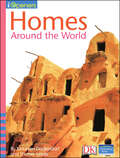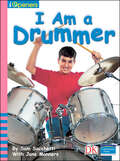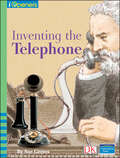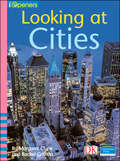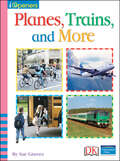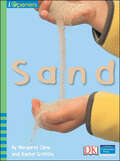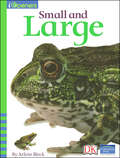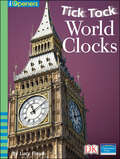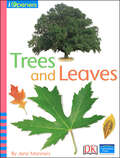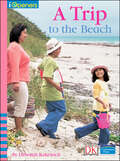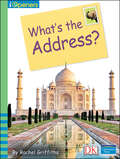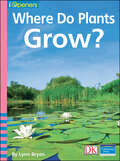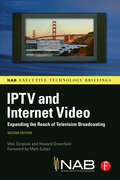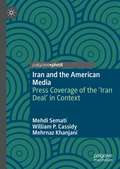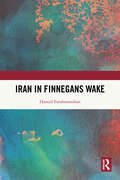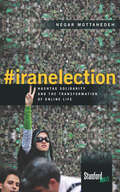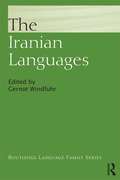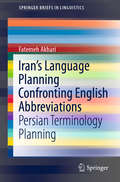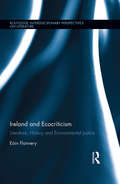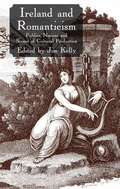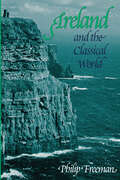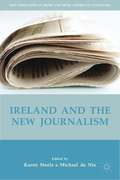- Table View
- List View
iOpener: Homes Around the World (iOpeners)
by Maureen Dockendork Sharon JeroskiThis 41-word book is a tour of homes around the world for young readers. It contains big, beautiful pictures of all sorts of homes--in the United States, Bolivia, Mongolia, and more--focusing on words about shape, size, and location. There are questions at the end of the book to aid in discussion.Grade: KindergartenSubject: World CulturesGenre: Informational TextComprehension Skill/Strategy: Compare and ContrastDiagnostic Reading Assessment (DRA/EDL): 3Guided Reading Level: CLexile Level: 3DK's iOpeners equip K-6 students with the skills and strategies they need to access and comprehend nonfiction so that they are not only learning to read but reading to learn. The combination of high-interest content and eye-popping photography of iOpeners brings science and social studies topics to life, raises student achievement in reading, and boosts standardized test scores.
iOpener: I am a Drummer (iOpeners)
by Jane Manners Sam SacchettiIn I Am a Drummer, schoolchildren will read about Sam, a young drummer, and all the different ways he plays the drums. This title features clear photography, bright colors, and contains a lot of noisy words that are fun to read aloud. This 32-word book has discussion questions at the back to encourage reading comprehension.Grade: KindergartenSubject: Physical ScienceGenre: Biography/AutobiographyComprehension Skill/Strategy: Make InferencesDiagnostic Reading Assessment (DRA/EDL): 6Guided Reading Level: DLexile Level: 6DK's iOpeners equip K-6 students with the skills and strategies they need to access and comprehend nonfiction so that they are not only learning to read but reading to learn. The combination of high-interest content and eye-popping photography of iOpeners brings science and social studies topics to life, raises student achievement in reading, and boosts standardized test scores.
iOpener: Inventing the Telephone (iOpeners)
by Sue GravesThis 254-word book tells all about the history of the telephone from its invention by Alexander Graham Bell to its use today. This title includes an index and discussion questions to aid in reading comprehension.Grade: 1Subject: HistoryGenre: Nonfiction NarrativeComprehension Skill/Strategy: Identify Main Ideas/DetailsDiagnostic Reading Assessment (DRA/EDL): 18Guided Reading Level: JLexile Level: 17DK's iOpeners equip K-6 students with the skills and strategies they need to access and comprehend nonfiction so that they are not only learning to read but reading to learn. The combination of high-interest content and eye-popping photography of iOpeners brings science and social studies topics to life, raises student achievement in reading, and boosts standardized test scores.
iOpener: Looking at Cities (iOpeners)
by Margaret Clyne Rachel GriffithsIn Looking at Cities, beginning readers can explore all the features of a city: its busy streets, its tall buildings, and its many people. Beautiful photographs are accompanied by simple sentences to help new readers learn about cities. This 30-word book includes interactive questions at the back to aid in reading comprehension.Grade: KindergartenSubject: GeographyGenre: Informational TextComprehension Skill/Strategy: Identify Main Idea/DetailsDiagnostic Reading Assessment (DRA/EDL): 4Guided Reading Level: CLexile Level: 4DK's iOpeners equip K-6 students with the skills and strategies they need to access and comprehend nonfiction so that they are not only learning to read but reading to learn. The combination of high-interest content and eye-popping photography of iOpeners brings science and social studies topics to life, raises student achievement in reading, and boosts standardized test scores.
iOpener: Planes, Trains, and More (iOpeners)
by Sue GravesPlanes, Trains, and More will let young readers discover all the exciting ways people can travel: by airplane, by bicycle--and even by space shuttle! This 43-word book includes interactive questions at the back and uses large, colorful photos to teach children all about travel.Grade: KindergartenSubject: GeographyGenre: Informational TextComprehension Skill/Strategy: GeneralizeDiagnostic Reading Assessment (DRA/EDL): 6Guided Reading Level: DLexile Level: 6DK's iOpeners equip K-6 students with the skills and strategies they need to access and comprehend nonfiction so that they are not only learning to read but reading to learn. The combination of high-interest content and eye-popping photography of iOpeners brings science and social studies topics to life, raises student achievement in reading, and boosts standardized test scores.
iOpener: Sand (iOpeners)
by Margaret Clyne Rachel GriffithsThis 49-word book for young readers will teach all about sand, how it's made, and where it's found. Every page contains big, beautiful photographs, and there are discussion questions to aid in reading comprehension.Grade: 1Subject: Earth ScienceGenre: Informational TextComprehension Skill/Strategy: Identify Cause and EffectDiagnostic Reading Assessment (DRA/EDL): 8Guided Reading Level: ELexile Level: 8DK's iOpeners equip K-6 students with the skills and strategies they need to access and comprehend nonfiction so that they are not only learning to read but reading to learn. The combination of high-interest content and eye-popping photography of iOpeners brings science and social studies topics to life, raises student achievement in reading, and boosts standardized test scores.
iOpener: Small and Large (iOpeners)
by Arlene BlockThis colorful 89-word book of large and small animals helps young readers learn about animals, size, and opposites. Discussion questions are included to aid in reading comprehension.Grade: 1Subject: Life ScienceGenre: Informational TextComprehension Skill/Strategy: Compare and ContrastDiagnostic Reading Assessment (DRA/EDL): 4Guided Reading Level: CLexile Level: 4DK's iOpeners equip K-6 students with the skills and strategies they need to access and comprehend nonfiction so that they are not only learning to read but reading to learn. The combination of high-interest content and eye-popping photography of iOpeners brings science and social studies topics to life, raises student achievement in reading, and boosts standardized test scores.
iOpener: Star Pictures (iOpeners)
by Leslie KimmelmanStar Pictures introduces young readers to some key constellations, beautifully photographed and then outlined to show their shapes. This 43-word book will ignite schoolchildren's interest in astronomy. It also includes discussion questions to aid in reading comprehension.Grade: KindergartenSubject: Earth ScienceGenre: Informational TextComprehension Skill/Strategy: Use Picture CluesDiagnostic Reading Assessment (DRA/EDL): 4Guided Reading Level: CLexile Level: 4DK's iOpeners equip K-6 students with the skills and strategies they need to access and comprehend nonfiction so that they are not only learning to read but reading to learn. The combination of high-interest content and eye-popping photography of iOpeners brings science and social studies topics to life, raises student achievement in reading, and boosts standardized test scores.
iOpener: Tick Tock World Clocks (iOpeners)
by Lucy FloydThis 43-word book gives young readers a glimpse of clocks around the world: in big cities, small towns, in stations, and in parks. It identifies the geographical places where clocks can be found, along with a world map that details where all the photos of the clocks in the book were taken. Tick Tock World Clocks also includes discussion questions to aid in reading comprehension.Grade: 1Subject: World CulturesGenre: Informational TextComprehension Skill/Strategy: GeneralizeDiagnostic Reading Assessment (DRA/EDL): 4Guided Reading Level: CLexile Level: 4DK's iOpeners equip K-6 students with the skills and strategies they need to access and comprehend nonfiction so that they are not only learning to read but reading to learn. The combination of high-interest content and eye-popping photography of iOpeners brings science and social studies topics to life, raises student achievement in reading, and boosts standardized test scores.
iOpener: Trees and Leaves (iOpeners)
by Jane MannersIn Trees and Leaves, schoolchildren will learn to identify many different leaves and the trees they come from by their size, shape, and color. This 33-word book includes discussion questions and bright, clear photography to teach children all they need to know about leaves and trees.Grade: KindergartenSubject: Life ScienceGenre: Informational TextComprehension Skill/Strategy: Draw ConclusionsDiagnostic Reading Assessment (DRA/EDL): 6Guided Reading Level: DLexile Level: 6DK's iOpeners equip K-6 students with the skills and strategies they need to access and comprehend nonfiction so that they are not only learning to read but reading to learn. The combination of high-interest content and eye-popping photography of iOpeners brings science and social studies topics to life, raises student achievement in reading, and boosts standardized test scores.
iOpener: A Trip to the Beach (iOpeners)
by Deborah KekewichIn A Trip to the Beach, a family explores the beach and finds animals all over: by the water, in the sand, and at the shoreline. This 44-word book for young readers will introduce new words with clear, fun photographs of the beach and its inhabitants. It also includes discussion questions to aid in reading comprehension.Grade: KindergartenSubject: GeographyGenre: Nonfiction NarrativeComprehension Skill/Strategy: Identify Main Idea/DetailsDiagnostic Reading Assessment (DRA/EDL): 6Guided Reading Level: DLexile Level: 6DK's iOpeners equip K-6 students with the skills and strategies they need to access and comprehend nonfiction so that they are not only learning to read but reading to learn. The combination of high-interest content and eye-popping photography of iOpeners brings science and social studies topics to life, raises student achievement in reading, and boosts standardized test scores.
iOpener: What’s the Address? (iOpeners)
by Rachel GriffithsThis 186-word book teaches young readers all about addresses for every place, including the SkyDome in Canada and the Eiffel Tower in France! Each location is beautifully photographed and includes a little information about the place as well as its address. This title includes an index and discussion questions to aid in reading comprehension.Grade: 1Subject: GeographyGenre: Informational TextComprehension Skill/Strategy: Use Graphic SourcesDiagnostic Reading Assessment (DRA/EDL): 10Guided Reading Level: FLexile Level: 19DK's iOpeners equip K-6 students with the skills and strategies they need to access and comprehend nonfiction so that they are not only learning to read but reading to learn. The combination of high-interest content and eye-popping photography of iOpeners brings science and social studies topics to life, raises student achievement in reading, and boosts standardized test scores.
iOpener: Where Do Plants Grow (iOpeners)
by Lynn BryanIn Where Do Plants Grow?, young readers will discover all the places on earth where plants live. From cactuses in the desert to seaweed in the ocean, this 28-word book covers a basic tour of plant life and its habitat. It also includes glossary terms and discussion questions to aid in reading comprehension. Grade: KindergartenSubject: Earth ScienceGenre: Informational TextComprehension Skill/Strategy: Classify/CategorizeDiagnostic Reading Assessment (DRA/EDL): 6Guided Reading Level: DLexile Level: 5DK's iOpeners equip K-6 students with the skills and strategies they need to access and comprehend nonfiction so that they are not only learning to read but reading to learn. The combination of high-interest content and eye-popping photography of iOpeners brings science and social studies topics to life, raises student achievement in reading, and boosts standardized test scores.
IPTV and Internet Video: Expanding the Reach of Television Broadcasting (Nab Executive Technology Briefings Ser.)
by Wes Simpson Howard GreenfieldStake your claim in the rapidly growing IPTV market with a thorough understanding of the key trends and technological advances shaping the future of broadband video technology. Make informed business decisions with a working knowledge of changes in technology, services, and business models. Get an up-to-date picture of the industry with new forms of television delivery, the new standard for video delivery, and current market figures. With annual growth estimates at 32+% for the next six years, this is necessary reading for remaining current in the marketplace. The second edition covers the monetization of IPTV, the differences between IPTV & Internet video, trends for the future and industry expectations. Written by two leading digital media experts, each with 25 years technology development experience and global insight.
Iran and the American Media: Press Coverage of the ‘Iran Deal’ in Context
by Mehdi Semati William P. Cassidy Mehrnaz KhanjaniThis book investigates the American media coverage of the historic nuclear accord between the Islamic Republic of Iran and the world powers, commonly known as the Iran Deal. The analysis examines the sources of news and opinion expressed about the Iran Deal in The New York Times, The Washington Post and the national newscast of broadcast networks. The empirical component uses media sociology and indexing theory to determine the extent to which the media covered the topic within a framework of institutional debates among congressional leaders, the executive branch and other governmental sources. The coverage is placed within a larger historical and interpretative framework that examines the construction of Iran in both the pre-revolution news narratives and in the post-revolution American media and popular culture. The book endeavors to reveal the place Iran occupies in the American political and cultural imagination.
Iran in Finnegans Wake
by Hamid FarahmandianIran in Finnegans Wake is a scholarly work that meticulously catalogs and analyzes the Iranian, Zoroastrian, and Persian vocabulary found in James Joyce's Finnegans Wake. This book is an invaluable resource for readers and scholars eager to uncover the intricate cultural and linguistic influences embedded within Joyce's enigmatic masterpiece.The book is organized according to the structure of Finnegans Wake, with each chapter corresponding to a specific section of the text. As readers progress through Joyce's work, they will find a thorough analysis of each Iranian, Zoroastrian, or Persian word in the order it appears. Entries include the word in its original script, a simple English translation, and a detailed explanation of its cultural significance and relevance within the context of Joyce's narrative. Introductory chapters provide essential background on the historical and cultural influences of these linguistic elements, deepening the reader's understanding of Joyce's engagement with Iranian traditions.This book targets a diverse audience, including scholars and enthusiasts of James Joyce's work who seek a deeper understanding of the cultural and linguistic dimensions within Finnegans Wake. It also appeals to academic institutions with programs in literary studies, comparative literature, Iranian studies, and Persian language departments, providing a valuable resource for courses and research focused on cross-cultural literary analysis and connections between Western and Iranian literature. Furthermore, libraries, research institutions, and general readers with an interest in James Joyce and cultural interplay in literature constitute potential markets for this comprehensive reference guide.
Iran Under the Pahlavi Monarchy: Essays in Iranian History, Politics, Culture and Literature (Iranian Studies)
by Homa KatouzianBringing together eighteen essays from Homa Katouzian, this book explores Iranian history, politics, culture and Persian literature from mediaeval times through the nineteenth century and into the contemporary period.Beginning with an overview of mediaeval Iranian history, the book then considers developments in the nineteenth century leading to the Constitutional Revolution of 1906-1911, which resulted in the fall of the Qajar dynasty (1785-1925). This is followed by a comprehensive overview of the Pahlavi monarchy (1925-1979) and a new and original analysis of the Iranian Revolution of February 1979. The book also includes essays on modern and classical Persian literature, encompassing Persian poetry and politics (1919-1925), the hitherto unstudied humour in Sadeq Hedayat’s life and works, a critical study of Forugh Farrokhzad, a study of Persian literary devices with special reference to the great Persian classic Sa‘di, and a study of Sa‘di as a lover of beauty and advocate of human morality.The book analyses Iran in a way that has seldom been done in one single volume – the history of the Qajar and Pahlavi dynasties, the two great revolutions in the twentieth century, and the unfamiliar nature of state and society in Iranian history, as well as some of the high points in modern and classical Persian literature – and is vital reading for anyone interested in the Middle East.
#iranelection: Hashtag Solidarity and the Transformation of Online Life
by Negar MottahedehThe protests following Iran's fraudulent 2009 Presidential election took the world by storm. As the Green Revolution gained protestors in the Iranian streets, #iranelection became the first long-trending international hashtag. Texts, images, videos, audio recordings, and links connected protestors on the ground and netizens online, all simultaneously transmitting and living a shared international experience. #iranelection follows the protest movement, on the ground and online, to investigate how emerging social media platforms developed international solidarity. The 2009 protests in Iran were the first revolts to be catapulted onto the global stage by social media, just as the 1979 Iranian Revolution was agitated by cassette tapes. And as the world turned to social media platforms to understand the events on the ground, social media platforms also adapted and developed to accommodate this global activism. Provocative and eye-opening, #iranelection reveals the new online ecology of social protest and offers a prehistory, of sorts, of the uses of hashtags and trending topics, selfies and avatar activism, and citizen journalism and YouTube mashups.
The Iranian Languages (Routledge Language Family Series)
by Gernot WindfuhrThe Iranian languages form the major eastern branch of the Indo-European group of languages, itself part of the larger Indo-Iranian family. Estimated to have between 150 and 200 million native speakers, the Iranian languages constitute one of the world’s major language families. This comprehensive volume offers a detailed overview of the principle languages which make up this group: Old Iranian, Middle Iranian, and New Iranian. The Iranian Languages is divided into fifteen chapters. The introductory chapters by the editor present a general overview and a detailed discussion of the linguistic typology of Iranian. The individual chapters which follow are written by leading experts in the field. These provide the reader with concise, non-technical descriptions of a range of Iranian languages. Each chapter follows the same pattern and sequence of topics, taking the reader through the significant features not only of phonology and morphology but also of syntax; from phrase level to complex sentences and pragmatics. Ample examples on all levels are provided with detailed annotation for the non-specialist reader. In addition, each chapter covers lexis, sociolinguistic and typological issues, and concludes with annotated sample texts. This unique resource is the ideal companion for undergraduate and postgraduate students of linguistics and language. It will also be of interest to researchers or anyone with an interest in historical linguistics, linguistics anthropology and language development. Gernot Windfuhr is Professor of Iranian Studies at the University of Michigan; he has published widely on Persian and Iranian languages and linguistics and related languages, as well as on other aspects of Iranian culture including Persian literature and Pre-Islamic Iranian religions.
Iran’s Language Planning Confronting English Abbreviations: Persian Terminology Planning (SpringerBriefs in Linguistics)
by Fatemeh AkbariThis book addresses one of the most crucial and common questions confronting planners of languages other than English, that is, how the impacts of global languages on local languages should be dealt with: internationalization or local language promotion? This empirical study examines the implementation of Iran’s governmental language and terminology policy to accelerate rarely used abbreviation methods in Persian in order to preserve the language from the extensiveness of borrowed English abbreviated forms. This book provides an in-depth analysis of relevant linguistic theories as well as the structure and social context of the Persian language itself, rather than relying on personal opinions or beliefs either in favour of or against abbreviation. The text appeals to politicians, language planners, terminologists, lecturers, authors and translators of scientific works, especially those who are speakers of languages other than English and seek to promote their local languages. This book is particularly relevant to linguistics students (both undergraduate and graduate students) and language teachers and researchers in the broader areas of language education and curriculum design.
Ireland and Ecocriticism: Literature, History and Environmental Justice (Routledge Interdisciplinary Perspectives on Literature)
by Eóin FlanneryThis book is the first truly interdisciplinary intervention into the burgeoning field of Irish ecological criticism. Providing original and nuanced readings of Irish cultural texts and personalities in terms of contemporary ecological criticism, Flannery’s readings of Irish literary fiction, poetry, travel writing, non-fiction, and essay writing are ground-breaking in their depth and scope. Explorations of figures and texts from Irish cultural and political history, including John McGahern, Derek Mahon, Roger Casement, and Tim Robinson, among many others, enable and invigorate the discipline of Irish cultural studies, and international ecocriticism on the whole. This book addresses the need to impress the urgency of lateral ecological awareness and responsibility among Irish cultural and political commentators; to highlight continuities and disparities between Irish ecological thought, writing, and praxis, and those of differential international writers, critics, and activists; and to establish both the singularity and contiguity of Irish ecological criticism to the wider international field of ecological criticism. With the introduction of concepts such as ecocosmopolitanism, "deep" history, ethics of proximity, Gaia Theory, urban ecology, and postcolonial environmentalism to Irish cultural studies, it takes Irish cultural studies in bracing new directions. Flannery furnishes working examples of the necessary interdisciplinarity of ecological criticism, and impresses the relevance of the Irish context to the broader debates within international ecological criticism. Crucially, the volume imports ecological critical paradigms into the field of Irish studies, and demonstrates the value of such conceptual dialogue for the future of Irish cultural and political criticism. This pioneering intervention exhibits the complexity of different Irish cultural and historical responses to ecological exploitation, degradation, and social justice.
Ireland and Romanticism
by Jim KellyThis collection by leading scholars in the field provides a fascinating and ground-breaking introduction to current research in Irish Romantic studies. It proves the international scope and aesthetic appeal of Irish writing in this period, and shows the importance of Ireland to wider currents in Romanticism.
Ireland and the Classical World
by Philip FreemanOn the boundary of what the ancient Greeks and Romans considered the habitable world, Ireland was a land of myth and mystery in classical times.<P><P> Classical authors frequently portrayed its people as savages—even as cannibals and devotees of incest—and evinced occasional uncertainty as to the island's shape, size, and actual location. Unlike neighboring Britain, Ireland never knew Roman occupation, yet literary and archaeological evidence prove that Iuverna was more than simply terra incognita in classical antiquity. <P> In this book, Philip Freeman explores the relations between ancient Ireland and the classical world through a comprehensive survey of all Greek and Latin literary sources that mention Ireland. He analyzes passages (given in both the original language and English) from over thirty authors, including Julius Caesar, Strabo, Tacitus, Ptolemy, and St. Jerome. To amplify the literary sources, he also briefly reviews the archaeological and linguistic evidence for contact between Ireland and the Mediterranean world. <P> Freeman's analysis of all these sources reveals that Ireland was known to the Greeks and Romans for hundreds of years and that Mediterranean goods and even travelers found their way to Ireland, while the Irish at least occasionally visited, traded, and raided in Roman lands. Everyone interested in ancient Irish history or Classics, whether scholar or enthusiast, will learn much from this pioneering book.
Ireland and the New Journalism
by Karen Steele Michael De NieThis volume explores the ways in which the complicated revolution in British newspapers, the New Journalism, influenced Irish politics, culture, and newspaper practices. The essays here further illuminate the central role of the press in the evolution of Irish nationalism and modernism in the late nineteenth and early twentieth centuries.
Ireland and the Problem of Information: Irish Writing, Radio, Late Modernist Communication (Refiguring Modernism #20)
by Damien KeaneThough the work of Irish writers has been paramount in conventional accounts of literary modernism, Ireland itself only rarely occupies a meaningful position in accounts of modernism’s historical trajectory. With an itinerary moving not simply among Dublin, Belfast, and London but also Paris, New York, Addis Ababa, Rome, Berlin, Geneva, and the world’s radio receivers, Ireland and the Problem of Information examines the pivotal mediations through which social knowledge was produced in the mid-twentieth century. Organized as a series of cross-fading case studies, the book argues that an expanded sphere of Irish cultural production should be read as much for what it indicates about practices of intermedial circulation and their consequences as for what it reveals about Irish writing around the time of the Second World War. In this way, it positions the “problem of information” as, first and foremost, an international predicament, but one with particular national implications for the Irish field.
